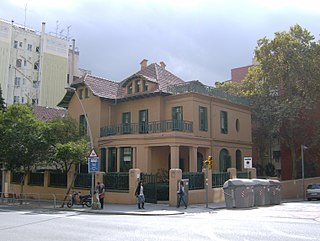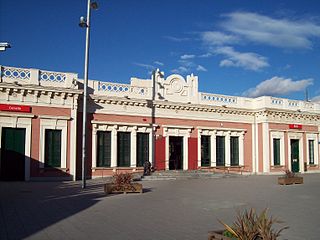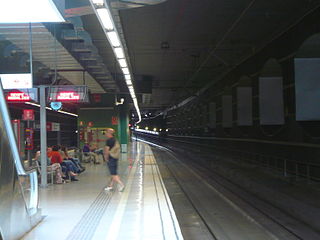
Castelldefels is a Rodalies de Catalunya railway station serving Castelldefels, in Catalonia, Spain. It is served by Barcelona commuter rail service lines R2 and R2 Sud, as well as some trains on regional lines R13, R14 and R15.

The Metropolitan Transport Authority is a public consortium intended to coordinate the operation and project the expansion of the public transport system in the Barcelona metropolitan area. It is made up of the Government of Catalonia and local administrations. It has been known as ATM Àrea de Barcelona since 2003 to differentiate it from the other existing Catalan public transport authorities in the Girona, Camp de Tarragona and Lleida areas, which are also identified as ATM. As of January 2015, the ATM-managed public transport system comprises 50 different operating companies and serves 346 municipalities, accounting for a population of over 5.7 million.

Cornellà Centre, also simply known as Cornellà, is a Rodalies de Catalunya and Barcelona Metro station, as well as Trambaix tram stop. It is located in the city centre of the Cornellà de Llobregat municipality, to the south-west of Barcelona, in Catalonia, Spain.

Barcelona Sant Andreu, previously Sant Andreu Comtal, is a Rodalies de Catalunya station in the Sant Andreu district of Barcelona. It is served by Barcelona commuter rail service lines R2 and R2 Nord, as well as regional line R11. Passengers can also commute here to Barcelona Metro line 1 station Sant Andreu. It is located completely over ground.

Sant Andreu Arenal is a Rodalies de Catalunya station in the Barcelona district of Sant Andreu. It is served by Barcelona commuter rail lines R3, R4 and R7 as well as regional line R12. Passengers can also commute here to Barcelona Metro line 1 station Fabra i Puig and the Sant Andreu bus terminal. It is located where Avinguda Meridiana and Avinguda de Rio de Janeiro meet, by Rambla de Fabra i Puig.

Barcelona El Clot-Aragó is a Rodalies de Catalunya station in El Camp de l'Arpa del Clot, in the Sant Martí district of Barcelona in Catalonia, Spain. It is served by Barcelona commuter rail service lines R1, R2 and R2 Nord, as well as Girona commuter rail service line RG1 and regional line R11. Passengers can commute here to Barcelona Metro station Clot. Like its metro counterpart, the station is completely underground, under Carrer d'Aragó and Avinguda Meridiana.
Torre del Baró is a Rodalies de Catalunya station in the Nou Barris district of Barcelona in Catalonia, Spain. It was opened in the 1970s and, since 2003, interconnected with the Barcelona Metro station Torre Baró-Vallbona. It is served by Barcelona commuter rail lines R3, R4 and R7 as well as regional line R12.

The R1 is a line of Rodalies de Catalunya's Barcelona commuter rail service, operated by Renfe Operadora. It runs northwards from the Barcelona area to the southern limits of the province of Girona, passing through the coastal Maresme region. Since 2014, some services have been extended further north towards Portbou, near the French border. These services are designated RG1 and are considered part of the Girona commuter rail service. The line had an annual ridership of 28 million in 2016, achieving an average weekday ridership of 102,214 according to 2008 data.

The R3 is a line of Rodalies de Catalunya's Barcelona commuter rail service, operated by Renfe Operadora. It runs northwards from the Barcelona area to the French border town of Latour-de-Carol, passing through the Vallès Oriental, Osona and Ripollès regions. With a total line length of 165.9 kilometres (103.1 mi), it extends notably beyond the limits of the Barcelona metropolitan area, reaching the Pyrenees mountains. According to 2008 data, the line's average weekday ridership is 22,841.

The R4 is a line of Rodalies de Catalunya's Barcelona commuter rail service, operated by Renfe Operadora. It runs northwards from the northern limits of the province of Tarragona to Barcelona, passing through the inland Alt Penedès region. The line then continues towards central Catalonia, describing a U-shaped route through the Barcelona area. According to 2008 data, the line's average weekday ridership is 105,935, the highest on any line of the Barcelona commuter rail service after the R2.

The R7 is a line of Rodalies de Catalunya's Barcelona commuter rail service, operated by Renfe Operadora. It links Sant Andreu Arenal railway station in northern Barcelona with Cerdanyola Universitat railway station, which serves the Bellaterra campus of the Autonomous University of Barcelona. The R7 shares tracks for most of its length with Barcelona commuter rail service lines R3 and R4, as well as regional rail line R12. According to 2010 data, the line's average weekday ridership is 8,140.

Rodalies de Catalunya is the main commuter and regional rail system in the Spanish autonomous community of Catalonia. It is administered by the Government of Catalonia and operated by the national rail operator Renfe Operadora. The system consists of 17 service lines chiefly centered in the Barcelona area, serving a total of 203 stations throughout Catalonia, with an average number of 1,000 trains running on it every day. In 2016, it had an annual ridership of 117 million.

Sitges is a Rodalies de Catalunya railway station serving Sitges, in Catalonia, Spain. It is served by Barcelona commuter rail service line R2 Sud as well as some trains on regional lines R13, R14 and R15.

The R8 is a line of Rodalies de Catalunya's Barcelona commuter rail service, operated by Renfe Operadora. It runs hourly between Martorell and Granollers across the Vallès Occidental region, spanning 40 kilometres (25 mi) and eight stations. The R8 primarily uses the Castellbisbal–Mollet-Sant Fost railway, as well as the Sant Vicenç de Calders–Vilafranca del Penedès–Barcelona and Barcelona–Cerbère railways on its southern and northern ends, respectively. It is currently the only line of the Barcelona commuter rail service entirely bypassing Barcelona. The trains operating on the line are Civia electrical multiple units (EMU).

El Prat de Llobregat or El Prat Estació is both a Rodalies de Catalunya and a Barcelona Metro station serving the suburb of El Prat de Llobregat, to the south-west of Barcelona, in Catalonia, Spain. It is on the conventional Madrid–Barcelona railway and is served by all trains on Barcelona commuter rail service lines R2 and R2 Nord, as well as some R2 Sud trains. Some trains on regional line R15 also call at the station. The metro station is on the airport branch of Barcelona Metro line 9 (L9) and is operated by Transports Metropolitans de Barcelona (TMB).

Granollers Centre is a Rodalies de Catalunya railway station serving Granollers in Catalonia, Spain. It is located on the Barcelona–Cerbère railway, just next to the Granollers main square.

The R11 is a line of Rodalies de Catalunya's regional rail service, operated by Renfe Operadora. It runs northwards from the Barcelona area to the French border town of Cerbère, passing through the Vallès Oriental, Selva, Gironès and Alt Empordà regions. With a total line length of 172 kilometres (107 mi), it extends notably beyond the limits of the Barcelona metropolitan area, reaching the Pyrenees mountains.

The R16 is a line of Rodalies de Catalunya's regional rail service, operated by Renfe Operadora. It runs southwards from the Barcelona area to the town of Tortosa, passing through the Vallès Occidental, Baix Llobregat, Garraf, Baix Penedès, Camp de Tarragona, Baix Ebre and Montsià regions. With a total line length of 172 kilometres (107 mi), it extends notably beyond the limits of the Barcelona metropolitan area, along the Mediterranean coast.
The R17 is a line of Rodalies de Catalunya's regional rail service, operated by Renfe Operadora. It runs southwards from the Barcelona area to Port Aventura, near the seaside resort of Salou, passing through the Vallès Occidental, Baix Llobregat, Garraf, Baix Penedès, Camp de Tarragona, Baix Ebre and Montsià regions. R17 trains run primarily on the Valencia−Sant Vicenç de Calders and Madrid–Barcelona railway, using Port Aventura as their southernmost terminus, and Barcelona Estació de França as its northern one. They use the Aragó Tunnel in Barcelona, where they share tracks with Rodalies de Catalunya's Barcelona suburban lines R2, R2 Nord and R2 Sud and regional rail lines R11, R13, R14, R15 and R16, calling at Sants and Passeig de Gràcia stations, while they continue to share tracks with Barcelona commuter rail service R2 Sud as far as Sant Vicenç de Calders, and with the Tarragona commuter rail service RT2 from Sant Vicenç de Calders to Port Aventura.
The RT2 is a line of Rodalies de Catalunya's Tarragona commuter rail service, operated by Renfe Operadora. It links Port Aventura railway station in the Costa Daurada area with L'Arboç railway station, in Baix Penedès, through the city of Tarragona. The RT2 shares tracks for most of its length with regional rail lines R15, R16 and R17, as well as Barcelona commuter rail service line R4.

















